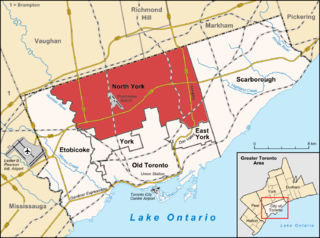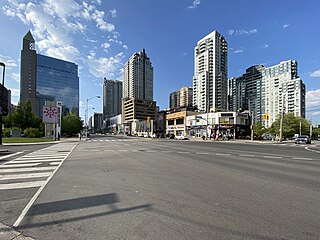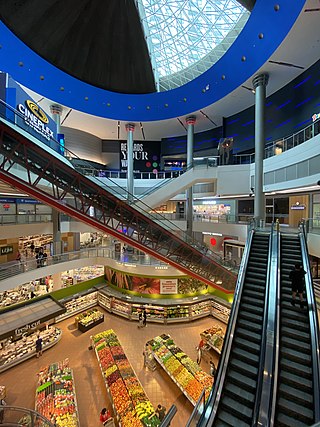
Melvin Douglas Lastman was a Canadian businessman and politician who served as the third mayor of North York from 1973 to 1997 and 62nd mayor of Toronto from 1998 to 2003. He was the first person to serve as mayor of Toronto following the 1998 amalgamation of Metro Toronto and its six constituent municipalities. Lastman is also known for having founded the Bad Boy Furniture chain.

Yonge–Dundas Square, or Dundas Square is a public square at the southeast corner of the intersection of Yonge Street and Dundas Street East in Downtown Toronto, Ontario, Canada. Designed by Brown and Storey Architects, the square was conceived in 1997 as part of revitalizing the intersection. Since its completion in 2002, the square has hosted many public events, performances and art displays, establishing itself as a prominent landmark in Toronto and one of the city's prime tourist attractions. Central to the Downtown Yonge entertainment and shopping district, the square is owned by the city and is the first public square in Canada to be maintained through a public–private partnership. The intersection is one of the busiest in Canada, with over 100,000 people crossing the city's first pedestrian scramble daily.

North York is a former township and city and is now one of the six administrative districts of Toronto, Ontario, Canada. It is located in the northern area of Toronto, centred around Yonge Street, north of Ontario Highway 401. It is bounded by York Region to the north at Steeles Avenue, on the west by the Humber River, on the east by Victoria Park Avenue. Its southern boundary is erratic and corresponds to the northern boundaries of the former municipalities of Toronto: York, Old Toronto and East York. As of the 2016 Census, the district has a population of 644,685.

North York City Centre is a central business district in Toronto, Ontario, Canada in the administrative district of North York. It is located along Yonge Street, between just south of Sheppard Avenue northward to Finch Avenue with its focus around Mel Lastman Square, a civic square, and spreads eastwards and westwards a few blocks, generally as far as Doris Avenue and Beecroft Road. The district is a high-density district of condominium and office towers with ground-floor commercial uses along the wide six lanes of Yonge Street.

The Toronto City Hall, or New City Hall, is the seat of the municipal government of Toronto, Ontario, Canada, and one of the city's most distinctive landmarks. Designed by Viljo Revell and engineered by Hannskarl Bandel, the building opened in 1965. The building is located adjacent to Nathan Phillips Square, a public square at the northwest intersection of Bay Street and Queen Street, that was designed and officially opened alongside Toronto City Hall.

Path is a network of underground pedestrian tunnels, elevated walkways, and at-grade walkways connecting the office towers of Downtown Toronto, Ontario, Canada. It connects more than 70 buildings via 30 kilometres (19 mi) of tunnels, walkways, and shopping areas. According to Guinness World Records, Path is the largest underground shopping complex in the world, with 371,600 square metres (4,000,000 sq ft) of retail space which includes over 1,200 retail fronts (2016). As of 2016, over 200,000 residents and workers use the Path system daily with the number of private dwellings within walking distance at 30,115.

The Old City Hall is a Romanesque-style civic building and former court house in Toronto, Ontario, Canada. It was the home of the Toronto City Council from 1899 to 1966 and a provincial court house until 2023, and remains one of the city's most prominent structures.

Nathan Phillips Square is an urban plaza in Toronto, Ontario, Canada. It forms the forecourt to Toronto City Hall, or New City Hall, at the intersection of Queen Street West and Bay Street, and is named after Nathan Phillips, mayor of Toronto from 1955 to 1962. The square was designed by the City Hall's architect Viljo Revell and landscape architect Richard Strong. It opened in 1965. The square is the site of concerts, art displays, a weekly farmers' market, the winter festival of lights, and other public events, including demonstrations. During the winter months, the reflecting pool is converted into an ice rink for ice skating. The square attracts an estimated 1.5 million visitors yearly. With an area of 4.85 hectares, it is Canada's largest city square.
Howard Moscoe is a former city councillor in Toronto, Ontario, Canada, representing Ward 15 in the western part of Eglinton-Lawrence. Among the most prominent and longest-serving councillors in the city, he is also known for an outspokenness which caused controversy at times. Moscoe is a member of the New Democratic Party. On August 31, 2010, after 31 years as an elected municipal politician, Moscoe announced his retirement from city council.

David Shiner was a city councillor in Toronto, Ontario, Canada. He represented ward 24, one of the two wards in Willowdale.

The North York Civic Centre is a municipal government building in Toronto, Ontario, Canada. It opened in 1979 as the city hall of the former city of North York. It is located in North York City Centre.

Mel Lastman Square is a public square at North York Civic Centre in Toronto, Ontario, Canada. It is named after then North York mayor Mel Lastman. It was officially opened on June 16, 1989, by Norman Jewison and Mel Lastman's granddaughter Brie Lastman. The architects were J. Michael Kirkland.

Albert Campbell Square is a public square in Scarborough City Centre in Scarborough, Toronto, Ontario, Canada. It is named after Albert Campbell, the first mayor of the Borough of Scarborough and former Chairman of the Municipality of Metropolitan Toronto. Albert Campbell Square is located at 150 Borough Drive, adjacent to the Scarborough Civic Centre south of Scarborough Centre station and Scarborough Town Centre shopping mall.

Empress Walk is a large Canadian condominium and retail complex in Toronto, Ontario, Canada. It is located at the intersection of Yonge Street and Empress Avenue in the North York Centre area of the North York district It was developed by Canadian-developers Menkes Developments Ltd. Phase 1 was completed in 1997 and Phase 2 was completed in 2000. It became an important retail complex in North York following its construction.
Esther Shiner was a municipal politician in Toronto, Ontario, Canada. She served on the North York city council from 1973 until her death, and was also a member of the Metropolitan Toronto council. She served as North York's Deputy Mayor in the 1980s.
Robert Frederick Murray Yuill, known as Bob Yuill, was a municipal politician in Toronto, Ontario, Canada.
William "Bill" Sutherland was a municipal politician in Toronto, Canada. He served on the North York City Council and the Metropolitan Toronto Council for several years, and challenged Mel Lastman for Mayor of North York in 1976.
David Kent Pecaut was an American-born Canadian civic leader. He co-founded and sat on the board of the Toronto City Summit Alliance.

Pecaut Square is a large concrete-and granite-clad plaza located in front of Metro Hall in Toronto, Ontario, Canada. The square supports the PATH network connection between Metro Hall and nearby buildings such as Metro Centre. Glass pavilions provide access to the PATH network.
Dale Martin is a former Canadian politician, who served on Toronto City Council from 1984 to 1988 and Metro Toronto Council from 1988 to 1991.















